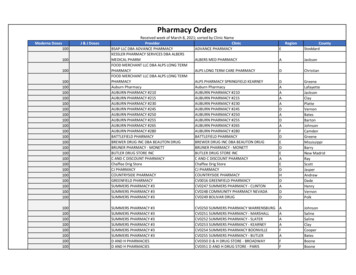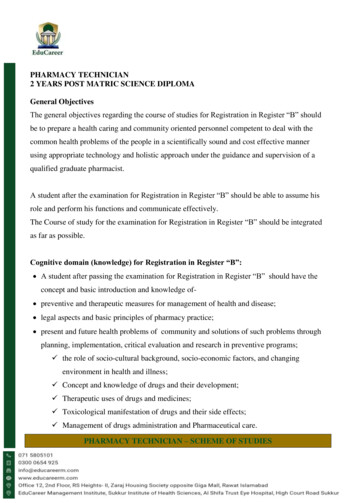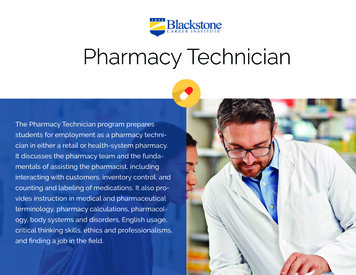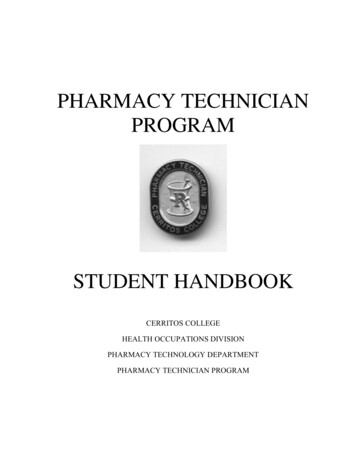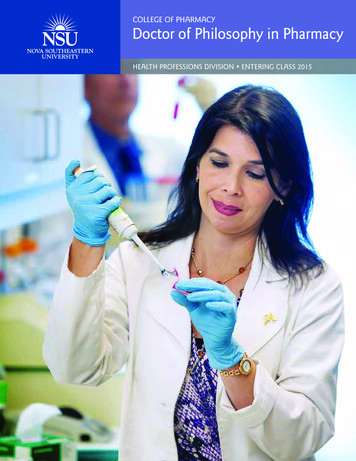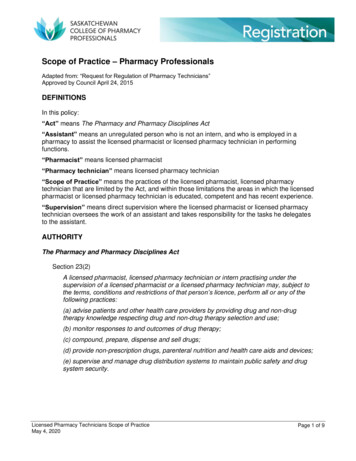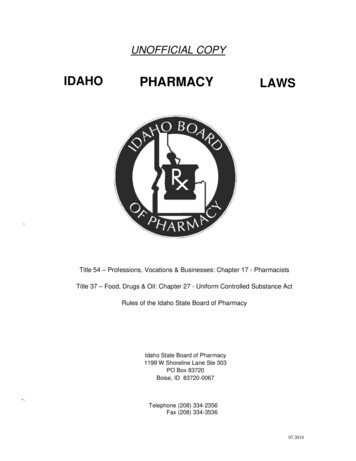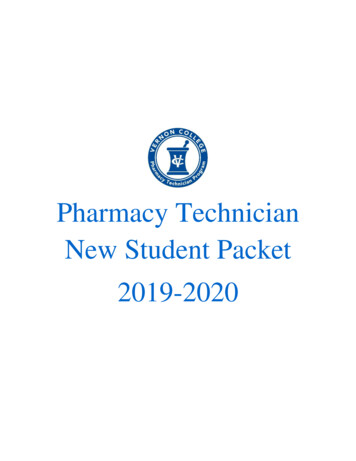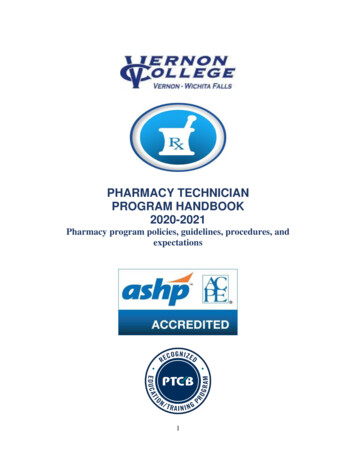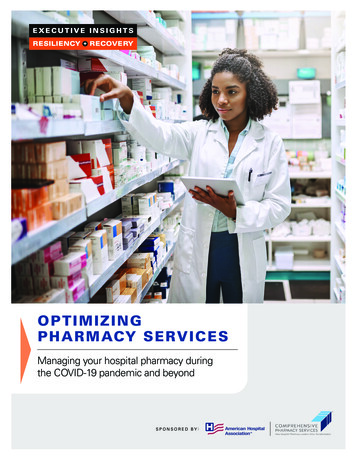
Transcription
EXECUTIVE INSIGHTSRESILIENCY RECOVERYO PT I M I Z I N GPH AR M ACY S E R VIC E SManaging your hospital pharmacy duringthe COVID-19 pandemic and beyondSPONSORED BY:
OPTIMIZING PHARMACY SERVICES:MANAGING YOUR HOSPITAL PHARMACY DURINGTHE COVID-19 PANDEMIC AND BEYONDCOVID-19 continues to dramatically impact the short- and long-term strategies ofhospitals and health systems, leaving much uncertainty regarding future financialstability and the ability to maintain excellent care for patients. Cancellation of nonelective procedures put facilities behind, reducing inpatient census and critically impactinghospital revenues. About two-thirds of hospital pharmacies have reduced staff as a result.Leading health system and hospital executives gathered for a virtual executive dialogue todiscuss the challenges they face and explore how the pharmacy can serve as a value driverin this difficult time. They shared insights into how optimizing pharmacy services can deliverclinical and operational benefits while also reducing costs and revealing new revenue opportunities, including those offered by telepharmacy and specialty pharmacy. KEY FINDINGS1232Supply shortages continue to challenge hospital pharmacy departments.The biggest staffing concern for hospital pharmacies is the ongoing shortage of pharmacytechnicians.Some hospitals see specialty pharmacy operations as a potential win for patient care andhospital finances, although they can be difficult to establish.EXECUTIVE INSIGHTS Sponsored by Comprehensive Pharmacy Services 2 0 2 0
V I R T U A L PA R T I C I PA N T SRandy Ball/VICE PRESIDENT AND SYSTEM PHARMACY OFFICERTEXAS HEALTH RESOURCES FORT WORTH,TEXASBrian Cherry/VICE PRESIDENT OF OPERATIONSCALVERT HEALTH PRINCE FREDERICK, MD.Gentry Hughes/EXECUTIVE VICE PRESIDENTCOMPREHENSIVE PHARMACY SERVICES MEMPHIS, TENN.Julia Ilyin/DIRECTOR OF PHARMACY SERVICESHACKENSACK MERIDIAN HEALTH MOUNTAINSIDE MEDICAL CENTER MONTCLAIR, N.J.Phyllis Lantos/SPECIAL ADVISER TO THE PRESIDENT AND CEONEW YORK-PRESBYTERIAN HOSPITAL NEW YORK CITYAl Patterson/CHIEF PHARMACY OFFICERBOSTON CHILDREN’S HOSPITALJulie Yaroch, D.O./SENIOR VICE PRESIDENT, PROMEDICA INPATIENT AND RETAIL PHARMACYPRESIDENT, PROMEDICA CHARLES AND VIRGINIA HICKMAN HOSPITALPROMEDICA ADRIAN, MICH.Thomas Yeager/DIRECTOR OF PHARMACYPENN HIGHLAND CLEARFIELD (PA.)M O D E R ATO RBob Kehoe/CONTENT DEVELOPMENT MANAGER, AHA CENTER FOR HEALTH INNOVATIONAMERICAN HOSPITAL ASSOCIATION3 CHICAGOEXECUTIVE INSIGHTS Sponsored by Comprehensive Pharmacy Services 2 0 2 0
E XECU T I V E I NS IGH TSOPTIMIZING PHARMACY SERVICES Managing Your Hospital Pharmacy During the COVID-19 Pandemic and BeyondMODERATOR: (Bob Kehoe, American Hospital As-sociation): What are some of the biggest pharmacy-related challenges your organization faces as thepandemic continues to unfold?AL PATTERSON (Boston Children’s Hospital): BostonChildren’s is a teaching hospital for Harvard Medical School and we have close working relationshipswith some of the other big hospitals in the Bostonarea. The biggest challenge we have had has beensecuring supplies. In the early days of the outbreak,the challenge was focused on neuromuscular sedatives. Any time there was an anecdotal report ofany medication having some sort of benefit, withinthe next six hours it was in short supply from everywholesaler. It was a knee-jerk reaction — you don’twant to be the last to the well — and unfortunatelyit got to be pretty ugly at times.I’m in pediatrics so we have not been impactedwith the patient loads to the same extent that ouradult counterparts have. Luckily, we have been ableto find supplies that have really helped to sustainsome of our adult counterparts in our region. Butsupplies continue to be a problem.One issue is that even before the pandemic, wewere already in a widespread drug shortage — particularly for us in pediatrics — regarding intravenous immunoglobulin (IVIG). That almost becameinstantaneously unavailable for some IVIG products. That has created a significant impact becauseof the multisystem inflammatory syndrome associated with COVID-19 for some children. We are aregional center for most of the Northeast and wehave handled now about 65 cases that have usedincredible amounts of IVIG. So that has been a realsupply issue for us.JULIA ILYIN (Hackensack Meridian Health MountainsideMedical Center): My hospital is part of Hackensack Meridian Health, which has 13 hospitals and more than200 ambulatory care centers, fitness and wellnesscenters, home health services, rehab centers and44skilled nursing centers in New Jersey. My biggestchallenge during the surge was operationalizing theIV-room compounding. Compounding the medications by hand for an average of 35-40 intubated patients on a daily basis took a tremendous toll on mystaff. Each of the vented patients probably neededon average five or six drips and these drips neededto be made daily because they are not commerciallyavailable.PHYLLIS LANTOS (New York-Presbyterian Hospital):Our system has more than 4,500 beds in 10 facilities, and at the peak of the surge here in New York,we had about 2,600 patients in the system whowere COVID-positive. Between 800 and 900 werein intensive care units, and most of them were onventilators. When the Northeast was one of thefirst hot spots in the country, we felt that we wereable to get the drugs we needed. But now that it’sspread throughout the country and there are manymarkets that are going to be in need, I think we willbe challenged to get access to supplies if New Yorkbecomes a hot spot again.JULIE YAROCH, D.O. (ProMedica): ProMedica has 12hospitals in Ohio and Michigan. When COVID-19 hit,we had the luxury of being in a multistate system —if we were short on propofol or albuterol at one hospital, we could obtain it from some of our regionalhospitals that did not have as many COVID-19 patients. Our Michigan hospitals took overflow patients from Detroit, and we were able to acquiresome medications through some of the state organizations that were put in place. That helped us significantly, particularly in our rural and critical accesshospitals that were treating COVID-19 patients.However, we continue to struggle with staffing concerns, particularly pharmacy techs. This has beenan ongoing issue for us but particularly during thispandemic when we turned a 72-bed hospital in Toledo into a full COVID-19 hospital. Staffing was ahuge issue because we needed to staff 24/7 whentypically we use after-hours pharmacy solutions forEXECUTIVE INSIGHTS Sponsored by Comprehensive Pharmacy Services 2 0 2 0
E XECU T I V E I NS IGH TSOPTIMIZING PHARMACY SERVICES Managing Your Hospital Pharmacy During the COVID-19 Pandemic and Beyondour smaller hospitals. But we couldn’t do that whenwe were treating coronavirus patients. Typically, wemight have three critical care patients in a 72-bedhospital but, during the surge, we went to as manyas 34 at one time on ventilators.the discussions and decisions regarding what treatment regimens we’d utilize and how we’d adjustbased on the most current information available. Itwas remarkable and inspiring to see this leadershiptransition.RANDY BALL (Texas Health Resources): Texas Healthed your organization to evaluate the state of yourResources serves the Dallas-Fort Worth area and surpharmacy more closely or look at how your operarounding counties. We have 14 wholly owned hospitions might need to change?tals and quite a few joint ventures and an affiliationwith the University of Texas SouthwestYAROCH: I don’t think we’re doingern Medical Center. There are a coupleanything drastic from an operationalof things that we already had put in placestandpoint, but we are going back tothat would have been hard to implement“Challenges thatenforce certain procedures that were induring the crisis but have shown a lot ofpharmacy leadersplace that maybe our teams have notbenefit. Prior to the onset of COVID-19,were experiencingbeen following. We are working withwe had centralized some of the orbefore theour purchasers now so we will be betder-verification processes, which allowspandemic havebeen magnified, andter prepared for future events.us to support all of our different entitieswe are seeing thatfrom a central location. There have beenprioritiescontinueWhen you go through a pandemic, ittimes when we have been short of emto shift because thecan point out how siloed some of our faployees in various hospitals becauseenvironment is socilities may be and how we really needof exposure to the virus and, by havingdynamic. ”to take advantage of that systematizathe central order verification, this has al— Gentry Hughes —tion. For example, we typically wouldn’tlowed us to support those hospitals.react to a drug study of 50 people orfewer. But when we heard of a solutionWe had also centralized a major porto help care for people on ventilatorstion of our purchasing. So, as we havewith high-flow oxygen, we bought a lot of drugs thatfought through the different shortages, staff memwe ultimately did not use. Even though we could rebers at every hospital are not having to try to dealturn some purchases, we couldn’t return everything.with the problem because we have a small team ofexperts working on it. Then we can move productBRIAN CHERRY (CalvertHealth): Calvert Health is aamong our different entities based on need. That100-bed hospital about 45 minutes southeast ofhas been a big benefit for us.Washington, D.C. We were able to see our pharmacy department transition from a valued supportWe also used our central pharmacy team to coordepartment of the care continuum to taking a signifdinate all the various research projects related toicant leadership role in how the hospital was treatCOVID-19 with which pharmacy is involved. This ining patients during the pandemic. We quickly develcludes not only the development of treatment prooped a COVID-19 treatment team that comprisedtocols, but keeping those up to date and communipulmonologists, hospitalists, ED and infectious discating with everybody who needs to know.ease providers. Our lab, ICU, community wellness,chief nursing officer and chief medical officer wereGENTRY HUGHES (Comprehensive Pharmacy Seralso on the team. Our pharmacy team facilitatedvices): Challenges that pharmacy leaders were expeMODERATOR: Has the impact of COVID-19 motivat-55EXECUTIVE INSIGHTS Sponsored by Comprehensive Pharmacy Services 2 0 2 0
E XECU T I V E I NS IGH TSOPTIMIZING PHARMACY SERVICES Managing Your Hospital Pharmacy During the COVID-19 Pandemic and Beyondriencing before the pandemic have been magnified,and we are seeing that priorities continue to shift because the environment is so dynamic. Leaders aretrying to build new contingency plans in preparationfor another potential resurgence in the short term oreven the longer term. We see a lot of focus on inventory optimization due to cash flow concerns.LANTOS: We are in a multiyear transition of movingto a uniform medical record system across all oursites. In anticipation of that, we are moving awayfrom separate formularies at each of the institutionsto having a single formulary. There was enormousprogress on this before COVID-19, but the pandemic has made clear the importance of centralizationand standardization for our pharmacies.So, we are doing a lot of work in that areaacross the sites.THOMAS YEAGER (Penn Highlands Clearfield): Penn Highlands Healthcare is afive-hospital system in central Pennsylvania. Our hospitals are all rural and we haven’t had a large influx of coronavirus casesat this time. We haven’t had to deal withmany drug shortages or personal protective equipment shortages, so we are tryingnot to be complacent and prepare for possible shortages this fall and winter.BALL: Our primary staffing issues have beenaround technicians, not pharmacists. We went intothis with some technician shortages — and we stillhave some shortages in this particular market rightnow, especially for higher-level job functions likeIV compounding. In March, I hired some pharmacystudents as interns to create an additional staffingpool and we have utilized them intermittently to fillin for technicians as needed.MODERATOR: Were you using remote pharmacyservices before the pandemic? Are you currentlylooking into telepharmacy as a potential way to increase bandwidth or generate additional revenue?“As a result ofthe pandemic,we went frommaybe 2% to 3% ofoutpatient volumeup to probably20% to 25% ofoutpatient physicianactivity now ontelemedicine.”YAROCH: Our larger facilities — 250beds and up — have 24/7 in-housepharmacy teams, while our smaller facilities use remote pharmacy servicesafter hours. The after-hours serviceshave been a huge advantage for us andhelped us from a cost perspective, particularly in our critical access or smallerrural hospitals.LANTOS: We have had telemedicineat the forefront for a number of yearsand have been working to grow it. As— Phyllis Lantos —a result of the pandemic, we went frommaybe 2% to 3% of outpatient volumeWe have been talking with our other localup to probably 20% to 25% of outpatienthealth care providers and the other hosphysician activity now on telemedicine.pitals in our system — we are all within 30 minutesTelepharmacy is a component of that.of each other — about how we will support one another if one of us has a surge of cases.YEAGER: We have never used telepharmacy here.Our hospitals are all small, but not critical access.MODERATOR: What kind of staffing issues have youWe each have a 12-hour pharmacy, and we havebeen dealing with because of the pandemic?integrated all of our processes and all of our orderplans.This standardization across the system simpliHUGHES: Many hospitals have had to quarantinefies things. Our nighttime verification comes fromkey members of their team and, frankly, didn’t haveour main hub hospital in a hub-and-spoke model.a plan to fill that gap. Staffing contingency plans areIf we had a staffing problem, our plan would be toa new area that I don’t think has really been evaluutilize a lesser-hit hospital to allow us to provide orated previously.der verification for the other facilities in our system.66EXECUTIVE INSIGHTS Sponsored by Comprehensive Pharmacy Services 2 0 2 0
E XECU T I V E I NS IGH TSOPTIMIZING PHARMACY SERVICES Managing Your Hospital Pharmacy During the COVID-19 Pandemic and BeyondMODERATOR: Does your organization own a spe-cialty pharmacy? If so, what insights can you share?we courier those meds straight to our patients’homes, we can do actual routes. This has beensuccessful and we have been able to grow. Wealso do our own medication packaging becausewe have robots that do our blister packs for us. Butyou definitely need a certain volume threshold tomake this work for your organization. It might notwork as well in more rural areas.PATTERSON: We are in the process of building itout right now. We have a partner because this isnot for the faint of heart. We have been trying todo this for 12 years and finally, with the impact ofCOVID-19 and the drop in revenue, it received attention. One of the drivers is that insurers are looking to white bag everything they possibly can and,MODERATOR: What are the lessons learned duringfor our infusion group, that is a huge challenge.the pandemic that you would share with other[White bagging means that a specialty pharmacypharmacy organizations that are looking for waysships a patient-specific drug to a provider’s officerto improve operations?for administration, removing the physician’s controlover the drug’s preparation and reducILYIN: The biggest thing is to be preing the payment the physician practicepared for medication shortages andreceives.] We are hopeful that this willsupply chain problems. There is a finegive us an opportunity to recapture notbalance between how much you want“There is a finejust the medical benefit but the pharmato stockpile versus how much youbalance betweency benefit levels as well for those pathink you will use, and we are definitehow much youwant to stockpiletients. The other issue is the continuumly watching that closely. We are alsoversus how muchof care for our pediatric patients, whowatching closely all the new protocolsyou think you willhave a fragmented care protocol whenfor potential treatments that are in theuse,andwearethey get most of their care here [at Bospipeline.definitely watchington Children’s] and then have to go tothat closely.”CVS or some other organization.CHERRY: One thing we learned, or— Julia Ilyin —maybe were simply reminded of, wasWe are simultaneously trying to workthe importance of recognizing our staff.out the logistics of getting our ownThe events of the last few months gavehome-infusion program up and runme an opportunity to frequently thankning. As long as the 340B [drug pricing program]our pharmacy team for everything they were doingbenefit lasts, that is economically viable. The maramidst the myriad changes our organization andgins will not be quite the same without 340B, butthe pandemic threw at them. They did a tremenit’s still the right thing to do from a patient care perdous job and it was great to continually remindspective. We expect to have this up and running bythem of that and thank them.the middle of 2021.LANTOS: Having an overarching view of the pharYAROCH: We have a specialty pharmacy program,macy across your system is important. A key thingand I think it makes sense in some communitiesfor us is centralization — getting standardizationand not in others. Our program is based in metand management of a single formulary and metricsro Toledo, where a higher percentage of patientsto monitor various sites.is being treated for HIV and hepatitis and rely onthose specialty meds. This is cost-efficient for usbecause we have a dense population so, when 77EXECUTIVE INSIGHTS Sponsored by Comprehensive Pharmacy Services 2 0 2 0
SPONSORComprehensive PharmacyServices was founded 50 yearsago. They are one of the nation’slargest providers of pharmacyservices — employing over 2,500professionals at over 800 hospitalsand healthcare facilities nationwide.They help clients tackle complexproblems with services acrossinpatient pharmacy managementand consulting, 340B, specialty andambulatory, TELE pharmacy, supplychain management, rehabilitationservices, and more. CPS helpspharmacy leaders achieve operationsexcellence, drive clinical quality, attaincontinuous regulatory compliance,and improve bottom-line performance— all while supporting staff,caregivers, and patients.FOR MORE 0 Comprehensive Pharmacy Services. All rights reserved.
JULIA ILYIN (Hackensack Meridian Health Mountainside Medical Center): My hospital is part of Hackensack Me - ridian Health, which has 13 hospitals and more than 200 ambulatory care centers, fitness and wellness centers, home health services, rehab centers and skilled nursing centers in New Jersey. My biggest
